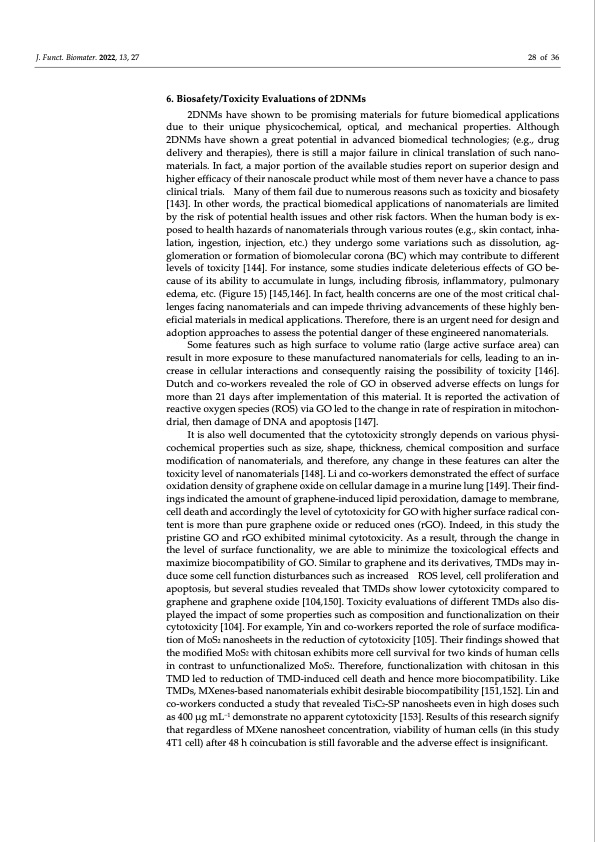
PDF Publication Title:
Text from PDF Page: 028
J. Funct. Biomater. 2022, 13, 27 28 of 36 6. Biosafety/Toxicity Evaluations of 2DNMs 2DNMs have shown to be promising materials for future biomedical applications due to their unique physicochemical, optical, and mechanical properties. Although 2DNMs have shown a great potential in advanced biomedical technologies; (e.g., drug delivery and therapies), there is still a major failure in clinical translation of such nano- materials. In fact, a major portion of the available studies report on superior design and higher efficacy of their nanoscale product while most of them never have a chance to pass clinical trials. Many of them fail due to numerous reasons such as toxicity and biosafety [143]. In other words, the practical biomedical applications of nanomaterials are limited by the risk of potential health issues and other risk factors. When the human body is ex- posed to health hazards of nanomaterials through various routes (e.g., skin contact, inha- lation, ingestion, injection, etc.) they undergo some variations such as dissolution, ag- glomeration or formation of biomolecular corona (BC) which may contribute to different levels of toxicity [144]. For instance, some studies indicate deleterious effects of GO be- cause of its ability to accumulate in lungs, including fibrosis, inflammatory, pulmonary edema, etc. (Figure 15) [145,146]. In fact, health concerns are one of the most critical chal- lenges facing nanomaterials and can impede thriving advancements of these highly ben- eficial materials in medical applications. Therefore, there is an urgent need for design and adoption approaches to assess the potential danger of these engineered nanomaterials. Some features such as high surface to volume ratio (large active surface area) can result in more exposure to these manufactured nanomaterials for cells, leading to an in- crease in cellular interactions and consequently raising the possibility of toxicity [146]. Dutch and co-workers revealed the role of GO in observed adverse effects on lungs for more than 21 days after implementation of this material. It is reported the activation of reactive oxygen species (ROS) via GO led to the change in rate of respiration in mitochon- drial, then damage of DNA and apoptosis [147]. It is also well documented that the cytotoxicity strongly depends on various physi- cochemical properties such as size, shape, thickness, chemical composition and surface modification of nanomaterials, and therefore, any change in these features can alter the toxicity level of nanomaterials [148]. Li and co-workers demonstrated the effect of surface oxidation density of graphene oxide on cellular damage in a murine lung [149]. Their find- ings indicated the amount of graphene-induced lipid peroxidation, damage to membrane, cell death and accordingly the level of cytotoxicity for GO with higher surface radical con- tent is more than pure graphene oxide or reduced ones (rGO). Indeed, in this study the pristine GO and rGO exhibited minimal cytotoxicity. As a result, through the change in the level of surface functionality, we are able to minimize the toxicological effects and maximize biocompatibility of GO. Similar to graphene and its derivatives, TMDs may in- duce some cell function disturbances such as increased ROS level, cell proliferation and apoptosis, but several studies revealed that TMDs show lower cytotoxicity compared to graphene and graphene oxide [104,150]. Toxicity evaluations of different TMDs also dis- played the impact of some properties such as composition and functionalization on their cytotoxicity [104]. For example, Yin and co-workers reported the role of surface modifica- tion of MoS2 nanosheets in the reduction of cytotoxicity [105]. Their findings showed that the modified MoS2 with chitosan exhibits more cell survival for two kinds of human cells in contrast to unfunctionalized MoS2. Therefore, functionalization with chitosan in this TMD led to reduction of TMD-induced cell death and hence more biocompatibility. Like TMDs, MXenes-based nanomaterials exhibit desirable biocompatibility [151,152]. Lin and co-workers conducted a study that revealed Ti3C2-SP nanosheets even in high doses such as 400 μg mL−1 demonstrate no apparent cytotoxicity [153]. Results of this research signify that regardless of MXene nanosheet concentration, viability of human cells (in this study 4T1 cell) after 48 h coincubation is still favorable and the adverse effect is insignificant.PDF Image | Nanomaterials beyond Graphene for Biomedical Applications

PDF Search Title:
Nanomaterials beyond Graphene for Biomedical ApplicationsOriginal File Name Searched:
jfb-13-00027.pdfDIY PDF Search: Google It | Yahoo | Bing
CO2 Organic Rankine Cycle Experimenter Platform The supercritical CO2 phase change system is both a heat pump and organic rankine cycle which can be used for those purposes and as a supercritical extractor for advanced subcritical and supercritical extraction technology. Uses include producing nanoparticles, precious metal CO2 extraction, lithium battery recycling, and other applications... More Info
Heat Pumps CO2 ORC Heat Pump System Platform More Info
| CONTACT TEL: 608-238-6001 Email: greg@infinityturbine.com | RSS | AMP |